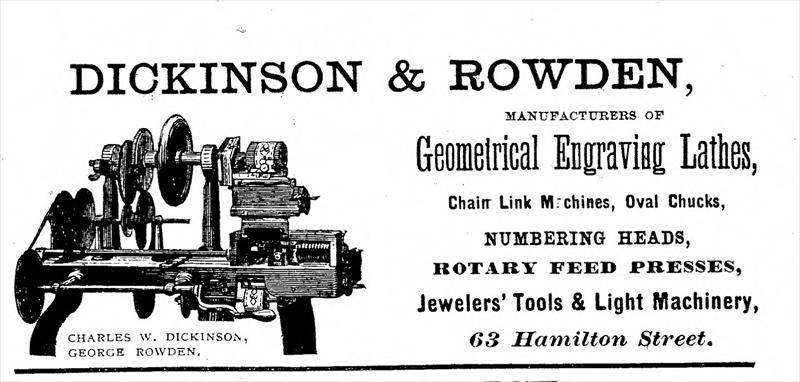This firm began as C. W. Dickinson in 1852. A decade later, George Rowden joined Charles W. Dickinson and the name became Dickinson & Rowden, specializing in bank note engravers' machinery, printing machinery, and jewelers' machinery. The business survived until at least 1874.
 |
| From 1874-75 Newark City Directory |
Information Sources
- We learned of this maker of a "patent engraving lathe and geometrical lathe" from an 1866 advertisement.
- From 1874 book, The Industrial Interests of Newark, N. J.
DICKINSON & ROWDEN, 63 Hamilton-street. This firm manufactures bank note engravers' machinery, etc., and was originally established in 1852 by Mr. Charles W. Dickinson, and is today without a rival in their special field of industry. The present firm name dates from 1862, when Mr. George Rowden became a partner in the business. Their productions consist of geometrical lathes, engravers' lathes, ruling machines, transfer presses, numbering heads for numbering bank notes and railroad tickets, rotary feed presses, and watch chain link machines, the last being the first one of Mr. Dickinsons many patents. They also make jewelers', chemists' and lapidists' tools, and fine machinery in general. The goods find a market mainly in the eastern States, but are sold all over the country, including Mexico. The first geometrical lathe was patented by a man named Spencer, and afterwards other lathes were made. The history of Mr. Dickinson's unrivalled success in this direction is briefly as follows: In 1862, when engaged in the manufacture of jewelers' tools, he received an order from Chicago parties for a geometrical lathe. Without previous experiment he at once began the work and the efforts, aided by his inventive genius, were crowned with success, the result being the most perfect lathe of the kind ever produced. The original parties not fulfilling their contract, the lathe was patented and sold to the United States Bank Note Company for $2,000, and on their failure it was sold at Sheriff's sale for $4,500. The geometrical lathe thus brought to perfection, is used in the United States Treasury Department, and by all the principal bank note companies. Six hands are employed by the firm, and their wages amount to $125 per week, the annual productions being valued at $10,000.